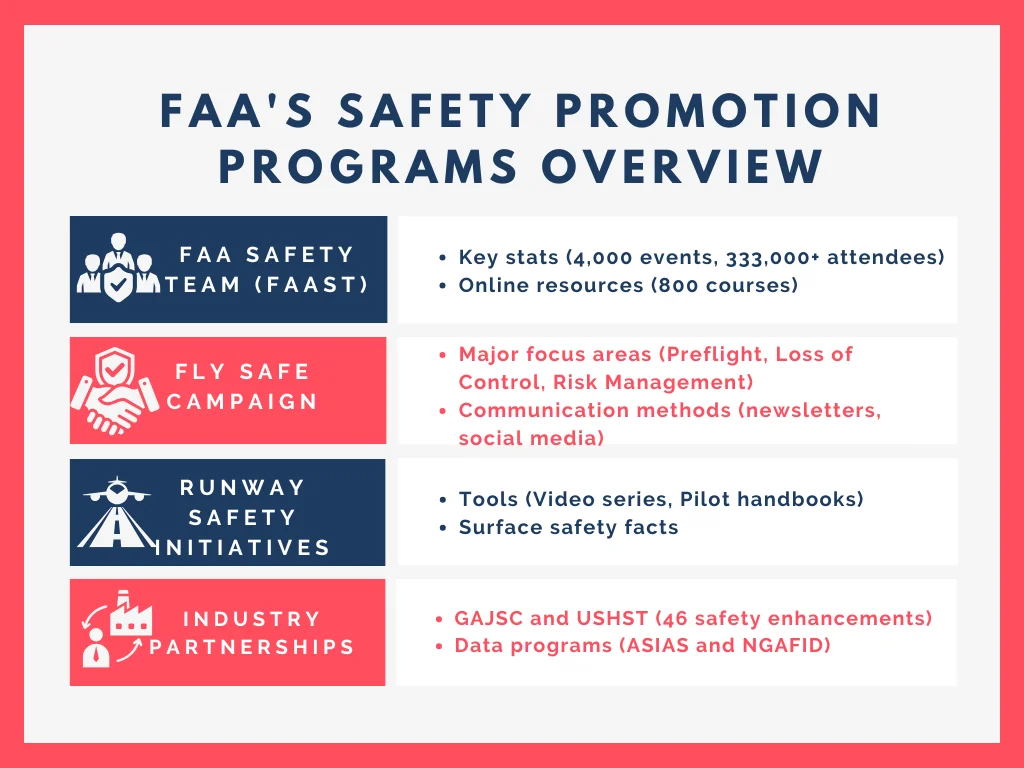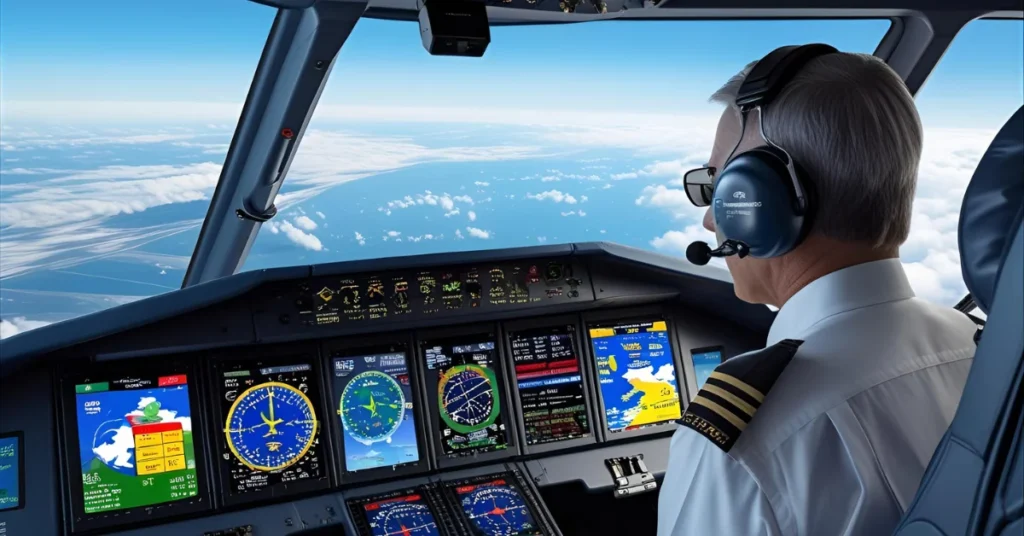FAA’s General Aviation Safety Promotion: General Aviation (GA) remains one of the most dynamic and diverse sectors in aviation, comprising over 275,000 aircraft across the United States.
Protecting its pilots, mechanics, and passengers is critical, and the Federal Aviation Administration (FAA) prioritizes safety through robust and comprehensive promotion and outreach programs.
These initiatives have proven essential in driving down fatalities and accidents and cultivating a safety-conscious culture within the GA community.
While the GA fatal accident rate reached an all-time low in 2024, with an estimated 0.68 fatal accidents per 100,000 flight hours, the FAA recognizes that continuous education, engagement, and technological support are vital for sustaining and accelerating safety improvements.
FAA’s Safety Promotion Programs Overview
1 .Championing Safety Culture: The FAA Safety Team (FAAST)
At the heart of the FAA’s outreach efforts is the FAA Safety Team, or FAAST—a national program designed to foster a proactive safety culture.
In 2024 alone, FAAST delivered nearly 4,000 safety seminars and webinars, drawing more than 333,000 attendees from across the aviation community.
FAAST supports both pilots and maintenance personnel through:
- Pilot Proficiency Programs like WINGS encourage ongoing training and skill maintenance.
- Maintenance Technician Awards recognize excellence and promote best practices among aviation mechanics.
- An extensive digital library hosted on FAASafety.gov, offering over 800 online courses and nearly 2,000 activities for anytime learning.
Beyond education, FAAST’s presence at major aviation events—such as the Experimental Aircraft Association’s AirVenture—reflects its commitment to accessible, real-world outreach.
By connecting pilots, mechanics, and regulators, FAAST cultivates shared responsibility for safety across the GA spectrum.
2.The Fly Safe Campaign: Critical Messages Delivered Consistently
Launched in 2015, the FAA’s Fly Safe Campaign represents a targeted effort to communicate vital safety principles to the GA community.
Developed in partnership with industry groups, the campaign focuses on key risk areas like:
- Preflight procedures, ensuring pilots fully prepare and assess risks.
- Loss of control in flight, a leading cause of GA accidents.
- Risk management, helping aviators make safer decisions under various conditions.
- Medical fitness, maintaining pilot health as a cornerstone of flight safety.
Fly Safe leverages multiple channels—monthly safety notices, FAA Safety Briefing magazine articles, social media platforms, and a quarterly newsletter—to consistently remind and educate aviators.
These sustained messages amplify awareness and encourage prudent flying habits.

3. Runway Safety: Reducing Surface Incidents Through Partnerships and Innovation
Runway and taxiway safety incidents remain significant hazards.
The FAA takes a collaborative approach with industry via Runway Safety Action Team (RSAT) meetings, which focus on understanding and mitigating surface risks by sharing data and best practices.
Key FAA tools to enhance runway safety include:
- The “From the Flight Deck” video series features cockpit footage that illustrates real runway approach challenges and “hot spots” known for confusion or incidents.
- Customized online pilot handbooks offering tailored safety information for more than 80 airports, including local controller advice.
- Arrival Alert Notices, which visually depict approach segments prone to alignment errors, help pilots prepare and avoid misapproaches.
These resources empower pilots with situational awareness that extends beyond technical flying skills to include operational context at airports nationwide.
4. FAA’s General Aviation Safety Promotion: Industry Collaboration Enhances Outreach Impact
Safety promotion is not conducted in isolation. The FAA’s partnership with industry bodies such as the General Aviation Joint Safety Committee (GAJSC) and the United States Helicopter Safety Team (USHST) has been instrumental in developing voluntary safety enhancements.
- To date, the GAJSC has created 46 safety enhancements targeting high-risk accident causes, like in-flight loss of control and powerplant failure.
- The USHST aims to reduce helicopter fatal accidents by significant margins by 2029 through targeted campaigns, education, and media, including podcasts and video courses like “56 Seconds to Live.”
- Safety data analysis programs such as the Aviation Safety Information Analysis and Sharing (ASIAS) and the National General Aviation Flight Information Database (NGAFID) give these teams insights to anticipate and address emerging risks proactively.
Harnessing Technology to Amplify Safety Outreach
The FAA actively promotes modern technologies that complement safety outreach by enhancing pilot awareness and situational decision-making:
- Automatic Dependent Surveillance-Broadcast (ADS-B) equips pilots with live graphical weather updates, traffic alerts, and critical flight restrictions, all shown right in the cockpit. ADS-B also enables faster and more efficient search and rescue operations by providing precise aircraft location data when emergencies occur.
- The Weather Camera Program delivers near-real-time visual weather conditions at airports, mountain passes, and historically accident-prone areas. With over 570 systems deployed nationwide and plans for 160 more sites by 2031, these cameras have already driven an 85% reduction in weather-related accidents in Alaska alone. This program supports pilots in making informed go/no-go decisions, especially under challenging weather conditions.

The Road Ahead: Sustaining Progress Through Outreach
FAA’s ongoing outreach and safety promotion are essential components in the broader strategy to reduce accidents and fatalities in General Aviation.
By focusing resources on education, community engagement, voluntary safety solutions, and innovative technology, the FAA has helped GA reach historic safety milestones.
However, the journey is far from complete. The FAA continues to evolve these programs and deepen partnerships to foster an enduring culture of safety, ensuring every GA pilot and mechanic has the knowledge and tools needed to fly safely.
In Summary: Why Safety Outreach Matters
| Why It Matters | FAA’s Response | Impact So Far (2024 & beyond) |
| GA fatal accidents remain a risk | FAAST, Fly Safe, RSAT proactive outreach | Lowest fatal accident rate since 2009 |
| Pilots and mechanics need ongoing education | WINGS program, online courses, seminars | Over 333,000 attendees in FAAST events |
| Surface incidents require special focus | Runway Safety Action Teams, video resources | Improved taxiway and runway awareness |
| Emerging risks require data-driven solutions | GAJSC, USHST, ASIAS, NGAFID partnerships | Development of 46+ safety enhancements |
| Weather and situational awareness are critical | Weather Camera Program, ADS-B promotion | Significant reduction in weather-related accidents |
The FAA’s safety promotion and outreach efforts represent the frontline defense for general aviation safety—empowering the community with knowledge, tools, and partnerships to fly smarter, safer, and with greater confidence.

